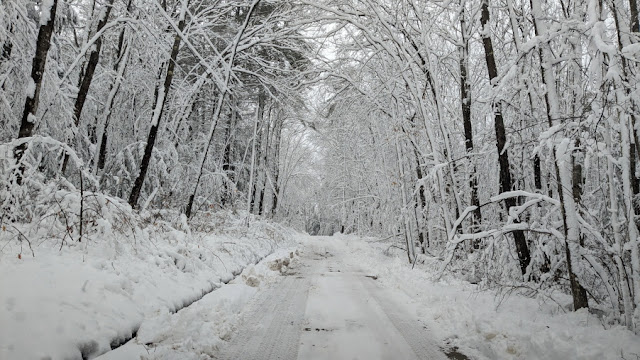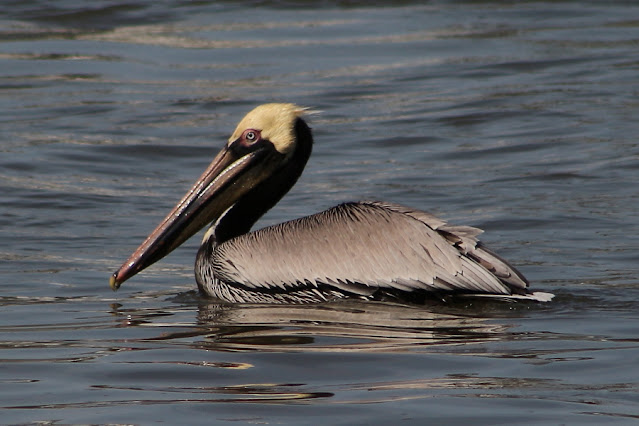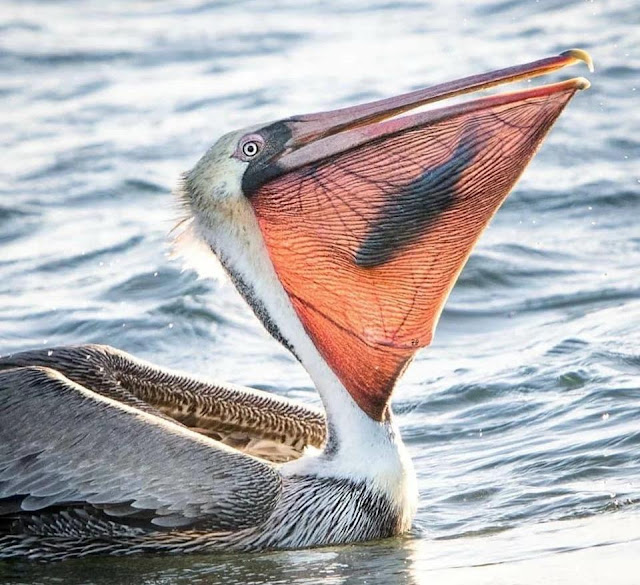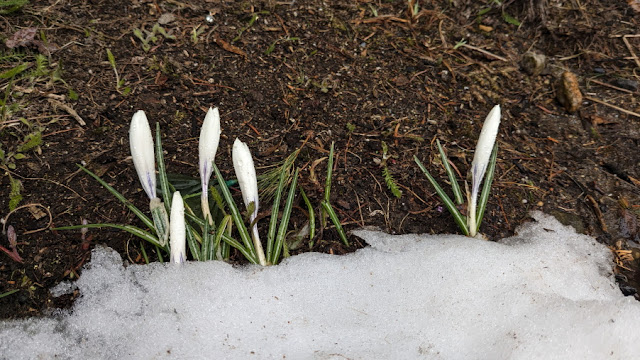 |
| Red Maple blossoms. |
Next onto the airborne signs of spring. The early migrants are starting to arrive in the Lakes Region; on one morning walk I heard or saw no less than 19 different bird species including my first warbler, the yellow-rumped, a blue-headed vireo, and a hermit thrush. There is no sound in the forest that's more comforting than the gentle, soothing flute of a hermit thrush. The phoebes on the other hand, are anything but soothing. Although a joy to hear, their call is loud, raspy, and somewhat harsh, and right now they are really making their presence known. Mr. Phoebe will sit outside on those red maples by the lake singing his heart out.
 |
| Eastern Phoebe in a Red Maple. |
And it's great fun to watch them flit up to catch an insect then return to their branch to wait for the next tiny morsel to fly by. I can't imagine how many gnats and black flies (yes, the black flies are out) they must consume every day. He makes quite a racket in the process of letting every other phoebe in a wide area know he's there.
Vernal pools are hotspots of life and biodiversity. Certain species, such as spotted, Jefferson, and marbled salamanders, wood frogs, and fairy shrimp (small, hearty crustaceans), need vernal pools to complete their lifecycles. Although they spend most of their lives on dry land, these species would not be able to survive without mating, laying eggs and developing in vernal pools. For that reason, they are called “obligate” species, meaning they are required — or obligated — to use a vernal pool. Other species like spring peepers, snails, clams, spotted and Blanding’s turtles, dragonflies and caddisflies use vernal pools but can also survive in other wetlands. The animal life in vernal pools is also a food source for predators, including great blue herons, racoons and insects.
And as if that's not enough to appreciate vernal pools, look at this gorgeous salamander Linda discovered while gardening yesterday.
 |
| Spotted Salamander (Ambystoma maculatum) |
The yellow-spotted salamander is a large mole salamander; this one was over six inches long.
Like most salamanders, the spotted salamander spends almost its entire life below ground, burrowing under large rocks, rotten logs, or under the leaf litter, eating slugs, spiders, insects, and algae. They emerge for only a few days in the spring to make their way to a vernal pool to mate. The mating ritual includes a dance routine by the male, which if successful, will result in a female following it to the water to lay her eggs. These predator-free vernal pools are essential to the survival of these amphibians which are a rare treat to find. We found this one under a large flower pot that spent the winter outside, and we carefully replaced the pot to restore its well-sheltered home.
You can read more about vernal pools here.
Speaking of vernal pools and water, a friend on the lake came across a neat poem titled "Lake Wicwas" which she sent to me. (Thank you SD!)
Lake Wicwas
I glide my paddle through the water,
pull toward the island, the lilies
on the surface parting at the bow.
My friend up ahead marks the path,
I find clarity in what is no longer hidden --
the sand and the rocks, minnows, and a can.
Now the only ripples cast are our own --
no thought of the election, no screech
of the prophet or of the abyss.
I glide my paddle through the water
and follow her, the artist maker,
translator of earth, and the way, and yes,
we are kayaking Lake Wicwas,
crossing the earth and the water,
the surface written and revised
by the seen and the unseen.
We glide our paddles through the water.
The lake reflects the cloudless morning sky --
blue heron glides, her wings arched upward
as we slow and hover, floating
between island and shore,
and turn to what cannot be known.
What cannot be known. Well said. This is in a book of poems about New Hampshire's lakes, ponds, and streams titled "Water Ways" by William O'Daly with essays and photography by J.S. Graustine. O'Daly lives in California, but Graustine is a Meredith local. Here's a description of the book by publisher Folded Word Press:
From the Connecticut Lakes to the Seacoast, Otter Brook to the Salmon Falls River, and the circumnavigation of Lake Winnipesaukee, the poems, essays, and photographs in this book celebrate New Hampshire’s gateways to “the most serene surface, the silence / of what we no longer remember: who we are, / to whom the loon calls across the emptiness.”
Innisfree Bookshop doesn't carry it, but you can find it at Folded Word Press.
I wonder if there's a poem in there about paddling on a beaver pond in spring.

















































